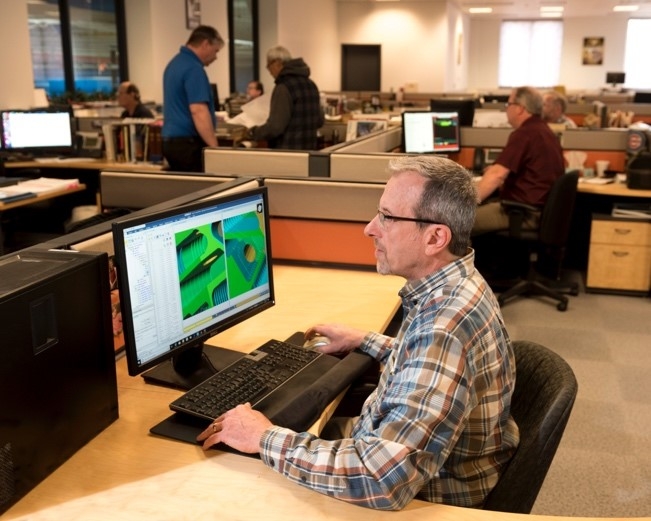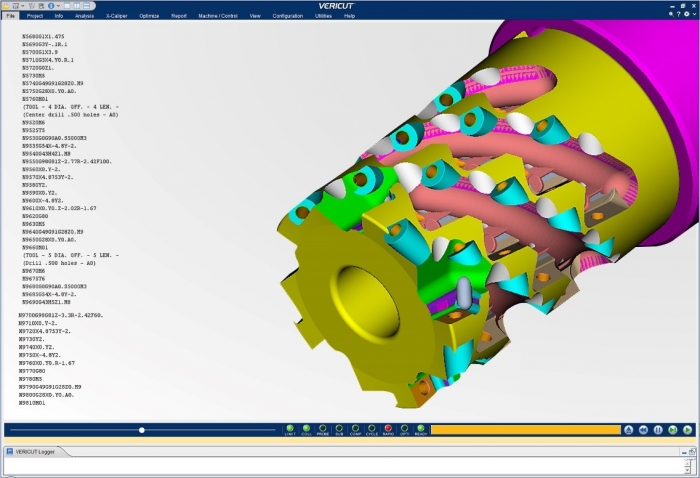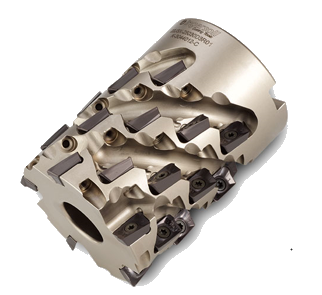Article from CGTech
Mike Gampetro has a great job. As a CNC programmer for the Proposal Engineering Dept. at Ingersoll Cutting Tools, Rockford, Illinois, he spends his days improving customers’ machining processes. It could be an Inconel part where Gampetro suggests ways to increase tool life, or it could be a long-runner where every second of cycle time counts. Either way, it’s his job to generate ideas his customers can then use to produce more parts in less time, and hopefully reduce their operating costs along the way.

Mike Gampetro, CNC programmer for the Proposal Engineering Dept. at Ingersoll Cutting Tools, spends his days looking for better ways to machine parts. Photos courtesy of Ingersoll Cutting Tools
Brother, can you lend a hand?
Whatever the case, he and Ingersoll are available to help machine shops of all sizes, and one of the tools they use to provide this no-cost assistance is VERICUT toolpath simulation software from Irvine, California-based CGTech. “In most cases, a customer sends me their VERICUT file and hopefully the NC program together with a tool list,” he says. “I’ll look at the existing metal-removal rate, the cycle time, and make recommendations on how they can improve the process.”
Quite often, Gampetro will need to reprogram the job from scratch. He’ll then run a comparison between his revised cycle time against the legacy program, using VERICUT to validate that his recommendations are solid. When done, he’ll send the customer a revised tooling list along with some screenshots of the process, and if the customer has VERICUT—which most do, Gampetro says—he’ll include that file in the package as well.
The results are well worth the effort. Gampetro is able to reduce most cycle times by at least 15%, with some enjoying a 50% or greater improvement. Although he’s unable to share any customer names, he noted that a well-known manufacturer of aerostructures in the Seattle area was one of the latter examples, and has since become a repeat visitor to Ingersoll’s optimization initiative as a result. “Some of our customers are producing very large, complex parts with cycle times of 40 hours or more,” he says. “Even a modest improvement pays huge dividends in these instances.”

Accurate simulation of machining processes is made possible through realistic 3D modeling of all cutting tools, workholding and CNC equipment.
Drinking the Kool-Aid
Gampetro has been in his current programming position for over two years, but his experience with VERICUT goes back far longer. That’s because he started out as a production programmer for Ingersoll in 1991, and the company has been using the toolpath simulation software in its own shop for the past two decades.
“We have extensive capabilities here and machine a wide range of complex geometries, everything from indexable turning and milling tools to special purpose cutters for automotive transfer lines,” he says. “Every single job is run through VERICUT before being released to the shop floor, to verify there won’t be a crash and that we have the best cycle time possible.”
Ingersoll also designs and manufactures custom cutting tools—lots of them—which Gampetro has recommended on more than one occasion. In one recent example, he couldn’t understand why one of his customers was using a ball-nosed endmill to surface the bottom of a deep slot. After speaking to the programmer there, Gampetro learned there wasn’t a standard slotting cutter available that could do the job, so the customer made do with what was on hand.
“All they needed was another half inch of reach, so we designed a special tool,” he says. “It made a huge difference on the cycle time, not to mention much better tool life.”

Don’t make do
Gampetro says this situation is not unusual. Despite the best of intentions, machine shop personnel everywhere are pushed to get jobs running as quickly as possible, and that shortcuts are sometimes taken. This is especially true in job shops, where optimization frequently plays second fiddle to machine uptime. “They’ll run into a hiccup, do a workaround to solve it, and then all of a sudden what should have been a really good NC program ends up taking longer than necessary.”
Nor do customers always like what Gampetro tells them, he notes. One shop came to him with an NC program for a 15-5PH stainless steel part that made extensive use of trochoidal milling strategies. When he reprogrammed the job to use plunge milling for a pocket roughing routine, the client balked.
“They said plunge milling is old school, and even after I showed them the simulation—which reduced the cycle time by 40 minutes—they insisted that trochoidal toolpaths are more efficient,” he says. “So we ordered a block of 15-5PH stainless, set it up at our Tech Center, and invited them to watch. Fortunately, most of our customers don’t need that level of proof, and become believers after seeing the VERICUT simulation.”
Start fresh
Sometimes, there’s no problem with a job at all, only opportunities to leverage newer cutting tool technology. When a machine shop has been running the same job or same material for years, it’s easy to become complacent, and it’s only by having a fresh set of eyes evaluate a machining process that higher-performing strategies can be brought to bear.
Gampetro is quick to point out that this isn’t some backwards sales pitch, designed to sell more cutting tools. Of course he recommends Ingersoll cutting tools where appropriate, and as already mentioned, custom-designed cutters often yield significant benefits. But if a customer’s legacy tooling gets the job done, by all means they should stick with what works. His job is to review part programs, evaluate where improvements can be made, simulate the changes in VERICUT, and pass his suggestions on to the end users.
“I’ve found many times that people will program a part, prove out the process, and no one will touch it for years and years,” he says. “It’s so easy to go back in and reprogram something and show them where they can improve. I don’t even push the tools as hard as I could, and use conservative feeds and speeds so that the customer can make additional improvements once they get the job back on their own machine. Even so, most of our customers are very happy when they leave here. VERICUT is a big part of that.”
Related Glossary Terms
- computer numerical control ( CNC)
computer numerical control ( CNC)
Microprocessor-based controller dedicated to a machine tool that permits the creation or modification of parts. Programmed numerical control activates the machine’s servos and spindle drives and controls the various machining operations. See DNC, direct numerical control; NC, numerical control.
- endmill
endmill
Milling cutter held by its shank that cuts on its periphery and, if so configured, on its free end. Takes a variety of shapes (single- and double-end, roughing, ballnose and cup-end) and sizes (stub, medium, long and extra-long). Also comes with differing numbers of flutes.
- gang cutting ( milling)
gang cutting ( milling)
Machining with several cutters mounted on a single arbor, generally for simultaneous cutting.
- metal-removal rate
metal-removal rate
Rate at which metal is removed from an unfinished part, measured in cubic inches or cubic centimeters per minute.
- milling
milling
Machining operation in which metal or other material is removed by applying power to a rotating cutter. In vertical milling, the cutting tool is mounted vertically on the spindle. In horizontal milling, the cutting tool is mounted horizontally, either directly on the spindle or on an arbor. Horizontal milling is further broken down into conventional milling, where the cutter rotates opposite the direction of feed, or “up” into the workpiece; and climb milling, where the cutter rotates in the direction of feed, or “down” into the workpiece. Milling operations include plane or surface milling, endmilling, facemilling, angle milling, form milling and profiling.
- numerical control ( NC)
numerical control ( NC)
Any controlled equipment that allows an operator to program its movement by entering a series of coded numbers and symbols. See CNC, computer numerical control; DNC, direct numerical control.
- pitch
pitch
1. On a saw blade, the number of teeth per inch. 2. In threading, the number of threads per inch.
- plunge milling
plunge milling
Highly productive method of metal removal in which an axial machining operation is performed in a single tool sequence. The tool makes a series of overlapping, drill-like plunges to remove part of a cylindrical plug of material one after another. Because of the increased rigidity of a Z-axis move, the tool can cover a large cross-section of material.
- slotting
slotting
Machining, normally milling, that creates slots, grooves and similar recesses in workpieces, including T-slots and dovetails.
- toolpath( cutter path)
toolpath( cutter path)
2-D or 3-D path generated by program code or a CAM system and followed by tool when machining a part.
- turning
turning
Workpiece is held in a chuck, mounted on a face plate or secured between centers and rotated while a cutting tool, normally a single-point tool, is fed into it along its periphery or across its end or face. Takes the form of straight turning (cutting along the periphery of the workpiece); taper turning (creating a taper); step turning (turning different-size diameters on the same work); chamfering (beveling an edge or shoulder); facing (cutting on an end); turning threads (usually external but can be internal); roughing (high-volume metal removal); and finishing (final light cuts). Performed on lathes, turning centers, chucking machines, automatic screw machines and similar machines.
